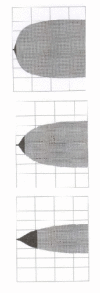An in vitro evaluation of standard rotational thromboelastography in monitoring of effects of recombinant factor VIIa on coagulopathy induced by hydroxy ethyl starch
- PMID: 15713229
- PMCID: PMC551614
- DOI: 10.1186/1471-2326-5-3
An in vitro evaluation of standard rotational thromboelastography in monitoring of effects of recombinant factor VIIa on coagulopathy induced by hydroxy ethyl starch
Abstract
BACKGROUND: Rotational thromboelastography (ROTEG) has been proposed as a monitoring tool that can be used to monitor treatment of hemophilia with recombinant factor VIIa (rFVIIa). In these studies special non-standard reagents were used as activators of the coagulation. The aim of this study was to evaluate if standard ROTEG analysis could be used for monitoring of effects of recombinant factor VIIa (rFVIIa) on Hydroxy Ethyl Starch-induced dilutional coagulopathy. METHODS: The study was performed in vitro on healthy volunteers. Prothrombin time (PT) and ROTEG analysis were performed after dilution with 33% hydroxy ethyl starch and also after addition of rFVIIa to the diluted blood. RESULTS: PT was impaired with INR changing from 0.9 before dilution to 1.2 after dilution while addition of rFVIIa to diluted blood lead to an overcorrection of the PT to an International Normalized Ratio (INR) value of 0.6 (p = 0.01). ROTEG activated with the contact activator ellagic acid was impaired by hemodilution (p = 0.01) while addition of rFVIIa had no further effects. ROTEG activated with tissue factor (TF) was also impaired by hemodilution (p = 0.01) while addition of rFVIIa lead to further impairment of the coagulation (p = 0.01). CONCLUSIONS: The parameters affected in the ROTEG analysis were Clot Formation Time and Amplitude after 15 minutes while the Clotting Time was unaffected. We believe these effects to be due to methodological problems when using standard activators of the coagulation in the ROTEG analysis in combination with rFVIIa.
Figures


Similar articles
-
Effect of hemodilution on coagulation and recombinant factor VIIa efficacy in human blood in vitro.J Trauma. 2011 Nov;71(5):1152-63. doi: 10.1097/TA.0b013e318215178c. J Trauma. 2011. PMID: 21610535
-
Prohemostatic Activity of Factor X in Combination With Activated Factor VII in Dilutional Coagulopathy.Anesth Analg. 2019 Aug;129(2):339-345. doi: 10.1213/ANE.0000000000003858. Anesth Analg. 2019. PMID: 30320649
-
Monitoring recombinant factor VIIa treatment: efficacy depends on high levels of fibrinogen in a model of severe dilutional coagulopathy.J Cardiothorac Vasc Anesth. 2008 Oct;22(5):675-80. doi: 10.1053/j.jvca.2008.01.017. Epub 2008 Apr 9. J Cardiothorac Vasc Anesth. 2008. PMID: 18922422
-
Mechanistic implications for the use and monitoring of recombinant activated factor VII in trauma.Crit Care. 2005;9 Suppl 5(Suppl 5):S15-24. doi: 10.1186/cc3781. Epub 2005 Oct 7. Crit Care. 2005. PMID: 16221315 Free PMC article. Review.
-
Potential role of recombinant factor VIIa as a hemostatic agent.Clin Adv Hematol Oncol. 2003 Feb;1(2):112-9. Clin Adv Hematol Oncol. 2003. PMID: 16224390 Review.
Cited by
-
Comparison of Two Different Fibrinogen Concentrates in an in vitro Model of Dilutional Coagulopathy.Transfus Med Hemother. 2020 Apr;47(2):167-174. doi: 10.1159/000502016. Epub 2019 Aug 16. Transfus Med Hemother. 2020. PMID: 32355477 Free PMC article.
-
Influence of alcohol consumption on blood coagulation in rotational thromboelastometry (ROTEM): an in-vivo study.Korean J Anesthesiol. 2020 Aug;73(4):334-341. doi: 10.4097/kja.20071. Epub 2020 Apr 16. Korean J Anesthesiol. 2020. PMID: 32299155 Free PMC article.
-
Optimal management of the critically ill: anaesthesia, monitoring, data capture, and point-of-care technological practices in ovine models of critical care.Biomed Res Int. 2014;2014:468309. doi: 10.1155/2014/468309. Epub 2014 Mar 25. Biomed Res Int. 2014. PMID: 24783206 Free PMC article. Review.
References
-
- Sauaia A, Moore FA, Moore EE, Moser KS, Brennan R, Read RA, Pons PT. Epidemiology of trauma deaths: a reassessment. J Trauma. 1995;38:185–193. - PubMed
LinkOut - more resources
Full Text Sources
Miscellaneous

